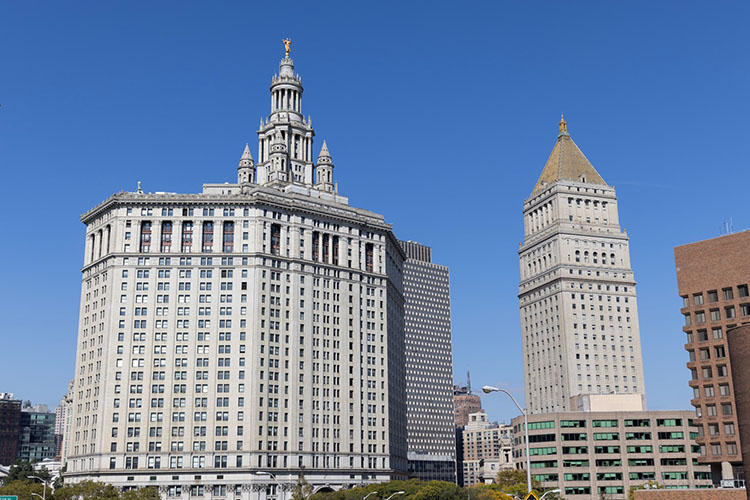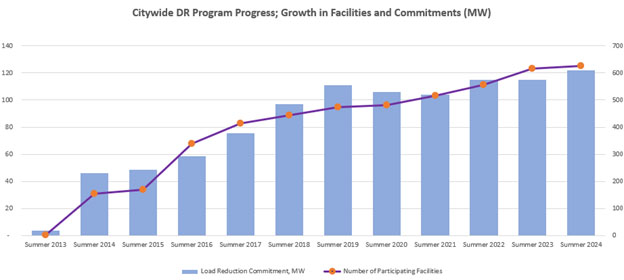DCAS Announces 600+ City Facilities to Participate in Summer Energy Reduction Program to Safeguard the City’s Electric Grid
July 10, 2024
Over 1,150 real-time meters have been installed to track city government’s electric usage, and assist with energy and emissions reduction efforts.
The City has already gained $120 million in revenue through the program.
NEW YORK - Today, the New York City Department of Citywide Administrative Services (DCAS) Commissioner Louis A. Molina announced a new expansion of the City’s successful Demand Response program, further reducing the City’s energy consumption, cutting carbon emissions, and safeguarding the local electric grid during the hottest summer months. As part of the program’s latest expansion, 627 city facilities across 36 agencies and organizations will participate with a load reduction commitment of 122 megawatts, the most facilities committed in the past 10 years, and a 13% increase in participation over the last two years.

Further, in an effort to help manage municipal electricity use across the city, DCAS is announcing the installation of more than 1,150 real-time meters (RTM) in City buildings. RTMs are an inexpensive, but innovative tool to monitor the City’s energy consumption, including electric, gas, and steam. Data collected by RTMs aids the City’s efforts to reduce energy consumption and emissions from government operations.
“Our city is leading the way in energy efficiency and sustainability – the expansion of the Demand Response program and the installation of real-time meters in city buildings are vital steps toward a greener, more resilient New York,” said First Deputy Mayor Sheena Wright. “This initiative not only reduces our carbon footprint, but also safeguards our power grid during the hottest months of the year. By investing in innovative solutions and harnessing the power of data, together, we are working to ensure a healthier, more sustainable future for all New Yorkers.”
“We are beyond excited that our already-successful Demand Response program and the installation of real-time meters are expanding. By optimizing energy use across hundreds of facilities, we not only cut carbon emissions but also enhance the reliability of our electric grid during peak summer months,” said DCAS Commissioner Molina. “Through this program, we are making significant strides in our mission to build a more sustainable and resilient city. This work is a testament to New York City's commitment to innovation and environmental stewardship, ensuring a greener future for all New Yorkers.”
"To reduce stress on our grid during peak demand days and transition to clean energy, we need energy-efficiency and conservation measures as well as renewable production methods," said Elijah Hutchinson, executive director, Mayor’s Office of Climate & Environmental Justice. "By expanding the Demand Response program, New York City government is leading by example, increasing grid reliability, and cutting costs while we cut carbon.”
Since the Demand Response program’s inception in 2013, city agencies have earned total program revenues of more than $120 million. Over the past two years, 72 new facilities have joined the program, including Governor’s Island, Brooklyn Cruise Terminal, Brooklyn Botanical Garden, and several New York City Public Schools. Collectively, it is estimated that energy consumption will be reduced by 122 megawatts during peak demand this summer, the equivalent of eliminating 130,000 miles worth of car emissions from New York City’s air. Participation in the program further mitigates the need for high-polluting power plants to increase output to meet the energy demands of the city.

“I'm proud that 430 New York City Public Schools buildings are currently enrolled to reduce electricity consumption during periods of peak stress on the electrical grid,” said Schools Chancellor David C. Banks. “Through this program and in tandem with other energy efficiency and sustainability initiatives, NYCPS is committed to reducing our environmental footprint while also increasing NYC’s resilience against the growing impacts of climate change.”
“Eleven acute care hospitals and three post-acute care facilities are enrolled in various Summer Demand Response programs to reduce electricity demand by around 10MW during peak periods,” said NYC Health + Hospitals Chief Decarbonization Officer Omer Cabuk. “These programs lower energy usage, reduce the need of operating more carbon-intensive power plants, and enhance grid stability. Through Demand Response and other decarbonization initiatives, NYC Health + Hospitals is committed to reducing its environmental footprint, meeting the City’s LL97 goals, and increasing climate resilience to ensure the continuity of its mission-critical functions during adverse climate events. We are grateful to our partners at DCAS for their support and investments in our infrastructure and decarbonization initiatives that help reduce emissions and contribute to a healthier, more sustainable city.”
“CUNY has diligently embraced measures to reduce power usage by our 25 campus communities across all five New York City boroughs, particularly during these sweltering summer months when the consumption of electricity reaches its peak,” said CUNY Chancellor Félix V. Matos Rodríguez. “Participation in the city’s Demand Response program is one piece of the important work we’ve done to conserve energy and ensure the resilience of the local grid networks that surround CUNY’s 300 buildings. We aim to sustain and expand these efforts to help New York City combat climate change.”
In 2015, DCAS began installing RTMs at City-owned buildings that collect and report energy consumption in real time, and inform strategic plans for building optimization. Now, nine years later, there are 1,100+ RTMs at more than 950 sites across the city. By tracking the data, DCAS tailors its approach to usage and ensures that buildings are using energy efficiently. The devices also help inform the City’s building retrofitting projects and capital upgrades. Since 2016, RTMs have helped inform countless energy efficiency projects, like addressing simultaneous heating and cooling at The Charles S. Hirsch Center for Forensic Sciences, saving $200,000 and 575 metric tons of CO2e; equipment scheduling at Whitehall Ferry Terminal, saving $145,000 and a similar 575 metric tons of CO2e annually; and an AC-unit plug load management project at several DCAS buildings, saving over $50,000 and 243 metric tons of CO2e annually.
While Demand Response is a key tool to reduce stress on the electric grid during heat emergencies, New Yorkers are also encouraged to conserve energy, especially during peak demand periods like heatwaves. The goal is to prevent overloading the power grids to ensure New Yorkers and their neighbors have reliable electricity service. New Yorkers can help achieve this by:
- Setting air conditioners to 78 degrees Fahrenheit.
- Utilizing timers to set cooling systems to begin working no more than a half hour prior to one’s arrival home.
- Refraining from using air conditioning when no one is home.
- Reducing indoor lighting and unplugging unused electronics.
Demand Response is one facet of the City’s larger decarbonization efforts. In June 2024, DCAS provided a comprehensive overview of the City’s progress and strategies for reducing greenhouse gas emissions and enhancing energy efficiency in public buildings. As highlighted in the Powering Change report, over the past decade, through targeted investments and efficiency measures made by the City, municipal buildings have seen an 8% reduction in energy consumption. Further, due to the collaboration between DCAS and sister agencies, city government has reduced its GHG emissions from its overall operations, including emissions from buildings, fleet, wastewater treatment and solid waste by over 25%. This is compared to a 17% reduction in emissions across the entire city, highlighting that the city government’s efforts to reduce emissions continue to be not only aggressive, but achievable.
About the NYC Department of Citywide Administrative Services
The NYC Department of Citywide Administrative Services (DCAS) makes city government work for all New Yorkers. Our commitment to equity, effectiveness, and sustainability guides our work providing City agencies with the resources and support needed to succeed, including:
- Recruiting, hiring, and training City employees.
- Managing 55 public buildings.
- Acquiring, selling, and leasing City property.
- Purchasing over $1 billion in goods and services for City agencies.
- Overseeing the greenest municipal vehicle fleet in the country.
- Leading the City’s efforts to reduce carbon emissions from government operations.
Learn more about DCAS by visiting nyc.gov/dcas and by following us on X, Instagram, Facebook, LinkedIn, and listening to the Inside Citywide podcast.
Contact:
Dan Kastanis
Director of Media Relations, DCAS
communications@dcas.nyc.gov




